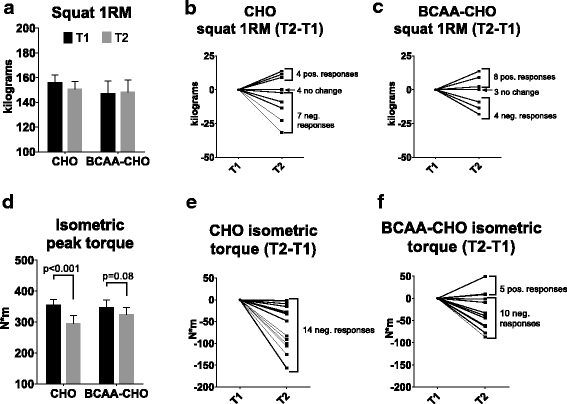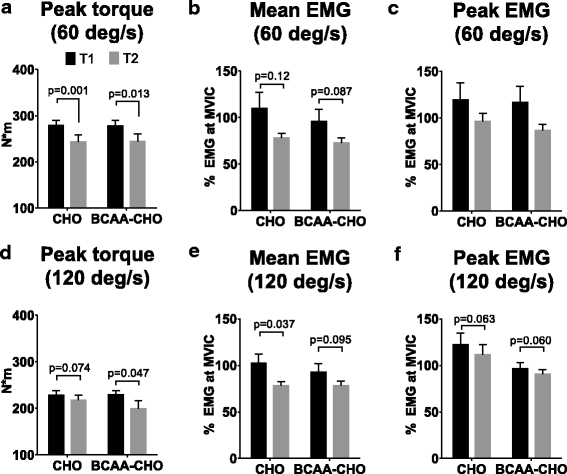Post-exercise branched chain amino acid supplementation does not affect recovery markers following three consecutive high intensity resistance training bouts compared to carbohydrate supplementation
- PMID: 27468258
- PMCID: PMC4962429
- DOI: 10.1186/s12970-016-0142-y
Post-exercise branched chain amino acid supplementation does not affect recovery markers following three consecutive high intensity resistance training bouts compared to carbohydrate supplementation
Abstract
Background: Amino acid supplementation has been shown to potentially reduced exercise-induced muscle soreness. Thus, the purpose of this study was to examine if branched chain amino acid and carbohydrate (BCAACHO) versus carbohydrate-only sports drink (CHO) supplementation attenuated markers of muscle damage while preserving performance markers following 3 days of intense weight training.
Methods: Healthy resistance-trained males (n = 30) performed preliminary testing (T1) whereby they: 1) donated a baseline blood draw, 2) performed knee extensor dynamometry to obtain peak quadriceps isometric and isokinetic torque as well as electromyography (EMG) activity at 60°/s and 120°/s, and 3) performed a one repetition maximum (1RM) barbell back squat. The following week participants performed 10 sets x 5 repetitions at 80 % of their 1RM barbell back squat for 3 consecutive days and 48 h following the third lifting bout participants returned for (T2) testing whereby they repeated the T1 battery. Immediately following and 24 h after the three lifting bouts, participants were randomly assigned to consume one of two commercial products in 600 mL of tap water: 1) BCAAs and CHO (3 g/d L-leucine, 1 g/d L-isoleucine and 2 g/d L-valine with 2 g of CHO; n = 15), or 2) 42 g of CHO only (n = 15). Additionally, venous blood was drawn 24 h following the first and second lifting bouts and 48 h following the third bout to assess serum myoglobin concentrations, and a visual analog scale was utilized prior, during, and after the 3-d protocol to measure subjective perceptions of muscular soreness.
Results: There were similar decrements in 1RM squat strength and isokinetic peak torque measures in the BCAA-CHO and CHO groups. Serum myoglobin concentrations (p = 0.027) and perceived muscle soreness (p < 0.001) increased over the intervention regardless of supplementation. A group*time interaction was observed for monocyte percentages (p = 0.01) whereby BCAA-CHO supplementation attenuated increases in this variable over the duration of the protocol compared to CHO supplementation.
Conclusion: BCAA-CHO supplementation did not reduce decrements in lower body strength or improve select markers of muscle damage/soreness compared to CHO supplementation over three consecutive days of intense lower-body training.
Keywords: Branched chain amino acids; Immune system; Muscle damage; Resistance training.
Figures




Similar articles
-
Effects of powdered Montmorency tart cherry supplementation on an acute bout of intense lower body strength exercise in resistance trained males.J Int Soc Sports Nutr. 2015 Nov 16;12:41. doi: 10.1186/s12970-015-0102-y. eCollection 2015. J Int Soc Sports Nutr. 2015. PMID: 26578852 Free PMC article. Clinical Trial.
-
The effects of acute branched-chain amino acid supplementation on recovery from a single bout of hypertrophy exercise in resistance-trained athletes.Appl Physiol Nutr Metab. 2017 Jun;42(6):630-636. doi: 10.1139/apnm-2016-0569. Epub 2017 Jan 27. Appl Physiol Nutr Metab. 2017. PMID: 28177706 Clinical Trial.
-
Comparison of ingesting a food bar containing whey protein and isomalto-oligosaccharides to carbohydrate on performance and recovery from an acute bout of resistance-exercise and sprint conditioning: an open label, randomized, counterbalanced, crossover pilot study.J Int Soc Sports Nutr. 2019 Aug 13;16(1):34. doi: 10.1186/s12970-019-0301-z. J Int Soc Sports Nutr. 2019. PMID: 31409363 Free PMC article. Clinical Trial.
-
The effect of branched-chain amino acid on muscle damage markers and performance following strenuous exercise: a systematic review and meta-analysis.Appl Physiol Nutr Metab. 2021 Nov;46(11):1303-1313. doi: 10.1139/apnm-2021-0110. Epub 2021 Oct 6. Appl Physiol Nutr Metab. 2021. PMID: 34612716
-
International society of sports nutrition position stand: nutrient timing.J Int Soc Sports Nutr. 2017 Aug 29;14:33. doi: 10.1186/s12970-017-0189-4. eCollection 2017. J Int Soc Sports Nutr. 2017. PMID: 28919842 Free PMC article. Review.
Cited by
-
The use of BCAA to decrease delayed-onset muscle soreness after a single bout of exercise: a systematic review and meta-analysis.Amino Acids. 2021 Nov;53(11):1663-1678. doi: 10.1007/s00726-021-03089-2. Epub 2021 Oct 20. Amino Acids. 2021. PMID: 34669012
-
Does external pneumatic compression treatment between bouts of overreaching resistance training sessions exert differential effects on molecular signaling and performance-related variables compared to passive recovery? An exploratory study.PLoS One. 2017 Jun 29;12(6):e0180429. doi: 10.1371/journal.pone.0180429. eCollection 2017. PLoS One. 2017. PMID: 28662152 Free PMC article.
-
Does Branched-Chain Amino Acids (BCAAs) Supplementation Attenuate Muscle Damage Markers and Soreness after Resistance Exercise in Trained Males? A Meta-Analysis of Randomized Controlled Trials.Nutrients. 2021 May 31;13(6):1880. doi: 10.3390/nu13061880. Nutrients. 2021. PMID: 34072718 Free PMC article.
-
The effect of acute branched-chain amino acids ingestion on rate of force development in different time intervals: a controlled crossover study.Front Nutr. 2025 Jan 8;11:1463202. doi: 10.3389/fnut.2024.1463202. eCollection 2024. Front Nutr. 2025. PMID: 39845911 Free PMC article.
-
Is Branched-Chain Amino Acids Supplementation an Efficient Nutritional Strategy to Alleviate Skeletal Muscle Damage? A Systematic Review.Nutrients. 2017 Sep 21;9(10):1047. doi: 10.3390/nu9101047. Nutrients. 2017. PMID: 28934166 Free PMC article.
References
-
- Clarkson PM, Nosaka K, Braun B. Muscle function after exercise-induced muscle damage and rapid adaptation. Med Sci Sports Exerc. 1992;24(5):512–20. - PubMed
Publication types
MeSH terms
Substances
LinkOut - more resources
Full Text Sources
Other Literature Sources
Medical
Miscellaneous
